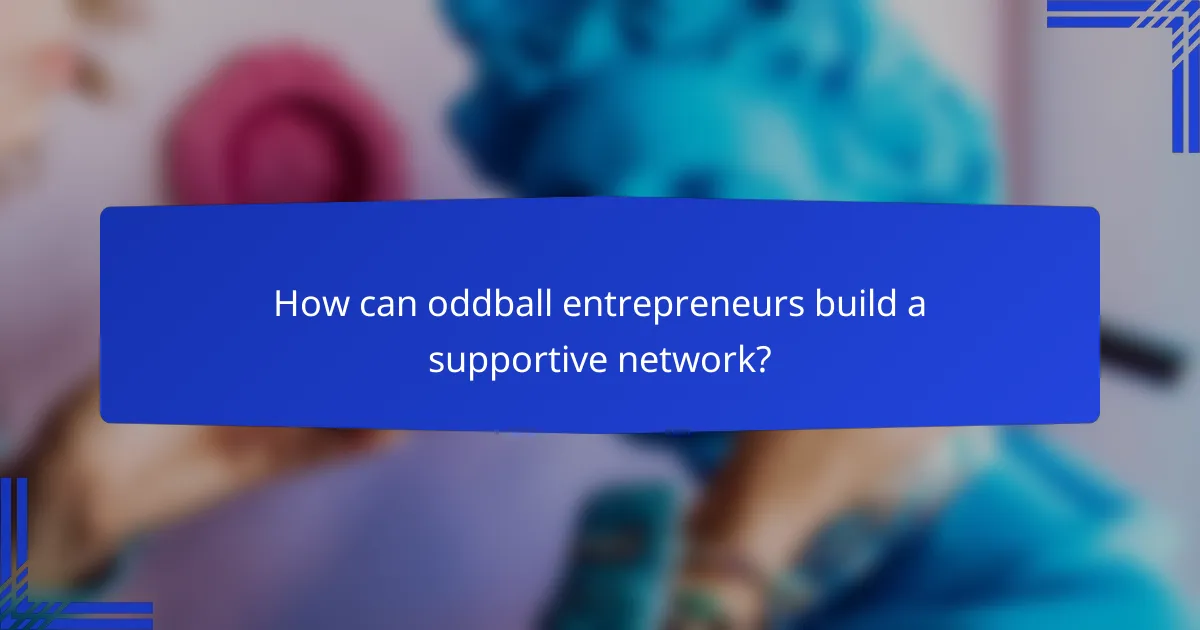Oddball entrepreneurs thrive by transforming initial market rejection into innovative success through their unique perspectives and unconventional ideas. Their personal anecdotes illustrate the resilience and creativity required to navigate challenges, ultimately allowing them to establish profitable niches and meaningful connections with their audiences.

How do oddball entrepreneurs succeed in Canada?
Oddball entrepreneurs in Canada succeed by leveraging their unique perspectives and embracing unconventional ideas that often face initial market rejection. Their resilience and innovative approaches allow them to carve out profitable niches and build strong connections with their target audiences.
Embracing market rejection
Embracing market rejection is a crucial step for oddball entrepreneurs. Instead of viewing rejection as a failure, they see it as an opportunity to refine their ideas and better understand their audience. This mindset allows them to pivot and adapt their offerings based on feedback.
For instance, a Canadian startup that initially faced criticism for its quirky product design might gather insights from potential customers and make adjustments that ultimately lead to a successful launch. Learning from rejection can transform initial setbacks into valuable lessons.
Innovative product development
Innovative product development is at the heart of oddball entrepreneurship. These entrepreneurs often create products that challenge the status quo, incorporating unique features or unconventional materials. This innovation can attract niche markets that are eager for something different.
For example, a Canadian company might develop eco-friendly packaging solutions that stand out in a crowded market. By focusing on sustainability and creativity, they can appeal to environmentally conscious consumers, thus gaining a competitive edge.
Building a unique brand identity
Building a unique brand identity is essential for oddball entrepreneurs to differentiate themselves in the marketplace. A strong brand story that resonates with customers can foster loyalty and create a community around the product. This identity often reflects the entrepreneur’s personal values and vision.
Take, for instance, a Canadian craft brewery that embraces quirky flavors and local ingredients. Their branding might highlight their unconventional approach, attracting adventurous consumers who appreciate originality. This connection can lead to a dedicated customer base that supports their innovative offerings.

What personal anecdotes illustrate their journeys?
Personal anecdotes from oddball entrepreneurs reveal how market rejection can lead to innovative success. These stories often highlight resilience, creativity, and the ability to pivot in the face of adversity.
Case study: David Karp and Tumblr
David Karp founded Tumblr in 2007, initially facing skepticism from investors who doubted the platform’s potential. Despite this rejection, Karp focused on building a user-friendly microblogging site that appealed to creative individuals, which eventually attracted millions of users.
One key moment in Karp’s journey was when he decided to ignore conventional social media trends and prioritize simplicity and aesthetics. This decision paid off, as Tumblr became a cultural phenomenon, particularly among younger audiences.
Case study: Sara Blakely and Spanx
Sara Blakely’s journey with Spanx began with her own frustration over uncomfortable undergarments. After facing numerous rejections from manufacturers, she persisted and eventually secured a deal with a department store, which marked a turning point for her brand.
Blakely’s innovative approach involved creating a product that addressed a common problem for women, which resonated widely. Her story emphasizes the importance of understanding customer needs and being willing to adapt, leading to Spanx becoming a billion-dollar company.

What challenges do oddball entrepreneurs face?
Oddball entrepreneurs often encounter unique challenges that stem from their unconventional ideas and approaches. These challenges include skepticism from potential investors and customers, difficulties in securing funding, and intense competition in niche markets.
Overcoming skepticism
Skepticism is a common hurdle for oddball entrepreneurs, as their innovative ideas may seem too radical or untested. To combat this, they should focus on building a strong narrative around their vision, highlighting the problem they solve and the potential impact of their solution.
Engaging with early adopters and gathering testimonials can also help to build credibility. Demonstrating proof of concept through prototypes or pilot programs can further alleviate doubts and attract interest.
Navigating funding obstacles
Securing funding can be particularly challenging for oddball entrepreneurs, as traditional investors may shy away from unconventional ideas. To navigate this, they should explore diverse funding sources, including crowdfunding platforms, angel investors, and grants specifically aimed at innovative projects.
Creating a compelling pitch that clearly outlines the business model, market potential, and unique value proposition is essential. Entrepreneurs should be prepared to articulate how their idea stands out and why it deserves investment.
Dealing with market competition
Oddball entrepreneurs often face competition from established players who may not be as innovative but have significant market presence. To effectively compete, they should identify and leverage their unique selling points, focusing on niche markets where they can excel.
Building a loyal customer base through exceptional service and community engagement can also provide an edge. Collaborating with other innovators or forming strategic partnerships can help to amplify their reach and resources in a crowded marketplace.

What strategies can help in overcoming rejection?
To overcome rejection, entrepreneurs can adopt strategies that focus on resilience, adaptability, and continuous improvement. By actively seeking feedback and iterating on their ideas, they can transform setbacks into opportunities for growth.
Leveraging customer feedback
Customer feedback is a valuable resource for entrepreneurs facing rejection. Gathering insights through surveys, interviews, or social media can help identify pain points and areas for improvement in a product or service. This direct input allows entrepreneurs to make informed adjustments that align better with market needs.
Consider implementing a structured feedback loop where customers can easily share their thoughts. For instance, using tools like Typeform or Google Forms can streamline the process. Aim for a response rate of around 10-20% to ensure a representative sample of opinions.
Iterative product testing
Iterative product testing involves continuously refining a product based on user interactions and feedback. This approach allows entrepreneurs to release a minimum viable product (MVP) and then gradually enhance it through multiple iterations. Each version should incorporate lessons learned from previous tests to better meet customer expectations.
Start with a small group of users to test your MVP, aiming for a diverse demographic to gather varied insights. Use their feedback to prioritize features and improvements, focusing on the most impactful changes. This method not only helps in overcoming initial rejection but also builds a loyal customer base that feels involved in the development process.

How can oddball entrepreneurs build a supportive network?
Oddball entrepreneurs can build a supportive network by actively engaging with like-minded individuals and seeking out communities that embrace unconventional ideas. This involves joining groups that align with their unique vision and finding mentors who understand their niche markets.
Joining entrepreneurial communities
Participating in entrepreneurial communities offers oddball entrepreneurs a platform to share ideas and gain feedback. Look for local meetups, online forums, or social media groups that focus on innovative business concepts. Engaging with these communities can lead to valuable connections and collaboration opportunities.
Consider attending industry-specific conferences or workshops where unconventional entrepreneurs gather. These events often provide networking sessions that can help forge relationships with peers who share similar challenges and aspirations.
Finding mentors in niche markets
Identifying mentors in niche markets is crucial for oddball entrepreneurs seeking guidance tailored to their unique ventures. Look for individuals who have successfully navigated similar paths and can offer insights based on their experiences. This could involve reaching out through professional networks or industry events.
When seeking a mentor, be clear about your goals and what you hope to learn. A good mentor can provide not only advice but also introductions to other valuable contacts within your niche, enhancing your network further.

What emerging trends are shaping oddball entrepreneurship?
Emerging trends in oddball entrepreneurship include the rise of social entrepreneurship, the integration of technology, and a focus on sustainability. These trends reflect a shift towards innovative business models that prioritize social impact alongside profitability.
Rise of social entrepreneurship
Social entrepreneurship is gaining momentum as entrepreneurs seek to address societal challenges while generating profit. This approach blends business acumen with a mission to create positive change, often targeting issues like poverty, education, and environmental sustainability.
Successful social entrepreneurs often leverage unique business models, such as hybrid structures that combine non-profit and for-profit elements. For example, a company might sell eco-friendly products while reinvesting a portion of profits into community development projects.
When considering social entrepreneurship, it’s crucial to define clear social goals and measure impact effectively. Entrepreneurs should avoid common pitfalls, such as diluting their mission for profit or neglecting stakeholder engagement. A focused business plan that aligns social objectives with financial goals can enhance sustainability and success.
